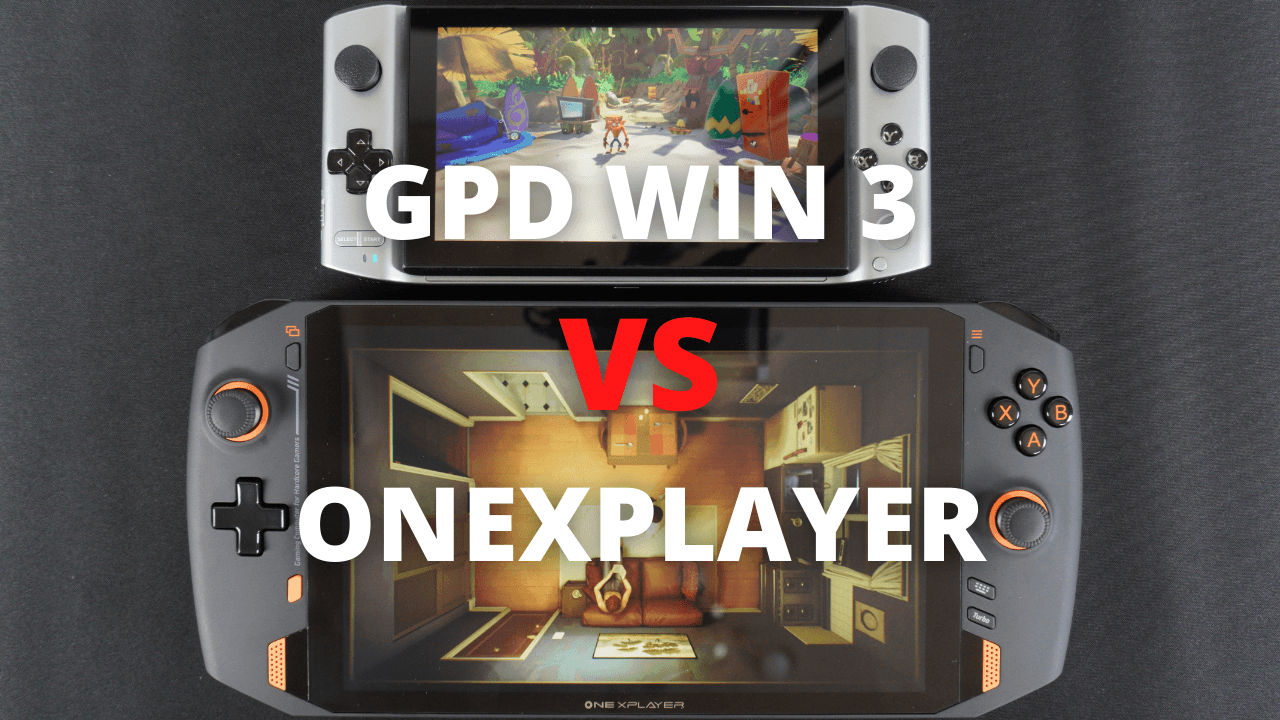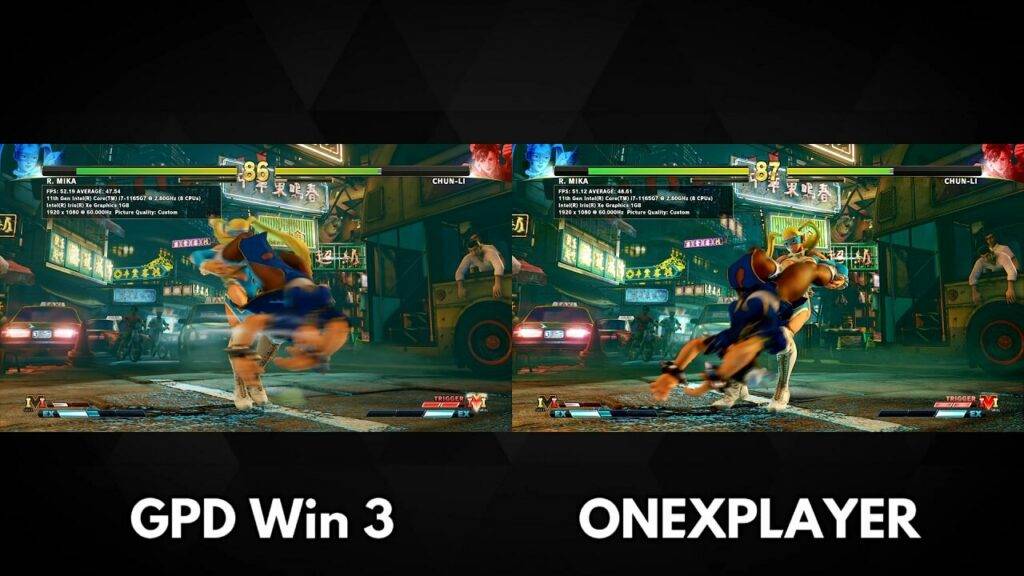In this blog post with video, we compare the GPD Win 3 vs ONEXPLAYER handheld gaming PC. We share our thoughts on the design, features, usage, benchmarks and games performance. Which is the best gaming handheld for you? Read on to find out!
GPD Win 3 vs ONEXPLAYER Comparison Video
You can find our video below. Or if you prefer to read, scroll a little further below for a text and image based version.
Technical Specifications
Both the GPD Win 3 and ONEXPLAYER have variations with i5 and i7 processors. In this article we are using the i7 models as a comparison. You can find out about them in our separate i5 vs i7 benchmarks for the GPD Win 3 here, and ONEXPLAYER here.
A very brief look at the technical specs for both:
| CPU | Intel i7-1165G7 with 4 cores, 8 threads and a Turbo Frequency up to 4.7GHz. |
| GPU | Intel Iris Xe Graphics with a maximum frequency of 1.30 GHz |
| RAM | 16GB of LPDDR4x RAM |
| STORAGE | 1TB Replaceable NVMe 1.4 PCIe Gen 4.0 |
| WIFI | WiFi 6 (IEEE 802.11ax) compatible, 2.4G / 5G Dual Band |
| BATTERY | 3x5000mAh (Win 3), 1×15,300mAh Battery (ONEXPLAYER) |
As you can see the specs are essentially identical. There is a difference between SSD manufacturers. This may result in differences in performance which we will test later.
GPD Win 3 vs ONEXPLAYER Overview
Design
The big difference between the two is of course the design.
You can read and watch our full GPD Win 3 review here. The Win 3 handheld game console is the smallest of the two measuring 7.8 x 3.6 x 1 inches (19.8 x 9.2 x 2.7 cm) in size and weighing 550 grams. The screen is a 5.5” display with a native resolution of 1280 x 720. In terms of controls it has your standard clickable dual analogues, classic digital pad. There are gaming buttons including trigger and shoulders, and a front facing fingerprint sensor.
You can read and watch our full ONEXPLAYER review here. The ONEXPLAYER handheld console is considerably larger and heavier than the Win 3, measuring 11.3 x 5.1 x 0.8 inches ( 28.8 x 13 x 2.1 cm) and weighing 820g. The screen is 8.3 inches IPS display, with a native resolution of 2560×1600. Like the Win 3, it has all your usual controls with the addition of three extra buttons; a desktop button, on-screen keyboard and a turbo mode button. On the back you can find the combined power and fingerprint sensor.
Keyboard
So we can see that both devices essentially have the same main features. The Win 3 does have a built-in keyboard which is useful for very brief usage, you wouldn't want to write a long document with it. The ONEXPLAYER has an on screen keyboard to compensate, which admittedly does work quite well but again, only for quick usage.
Size and Portability
The main difference is the size. The GPD Win 3 is far smaller and lighter, making it very portable. The Win 3 is so small, when placed on top of the ONEXPLAYER, it is around the size of the screen! You can easily fit the portable console inside your bag, or large jacket pocket for example.
The ONEXPLAYER weighs 270g more and to be honest, it is a bit on the limit in terms of portability. It is certainly not something that you would be able to fit in your jacket pocket, unless you have massive pockets. Depending on your bag, it may not even fit in fully!
True portability is definitely something that you will need to consider in deciding between the two. Do you want to be carrying around a very large handheld, or have something that can be easily stored in a pocket or bag. The GPD Win 3 for me personally wins here, it’s portable and lightweight!
ONEXPLAYER vs GPD Win 3 Display
More recently I have spent most of my time with the ONEXPLAYER. I have to say that I do enjoy using it a lot. It is the screen size that really appeals to me, it is massive! This means I can clearly see everything on screen, from text on the Windows handheld desktop through to on games which are very clear.
While making this video I went back to the Win 3 and immediately noticed what a difference the size in the screen made. Comparing the two side by side you can see the size!
There is also the difference in native resolution. The ONEXPLAYER is 2560×1600 and Win 3 is 1280×720. While you will not always be playing games at the high resolution, the opportunity to switch between them is very handy and definitely improves the overall quality. With the Win 3 you are pretty much stuck at 720P unless you output to a monitor.
The ONEXPLAYER definitely wins in terms of screen quality and size! Especially with the useful ability to change the resolution to lower when desired.
GPD Win 3 vs ONEXPLAYER Controls
The GPD Win 3 controls are a bit controversial according to feedback across various social media platforms. GPD seem to prefer this layout. The gaming buttons are below the right analogue stick which I have seen many complaints about. It can take some getting used to especially if you are a regular console gamer.
Overall the Win 3 is comfortable for extended periods of gaming. Ignoring the button layout, the analogues are easy to reach but if switching between those and the D-Pad you do find your hands readjusting often to have improved grip.
The ONEXPLAYER follows the more traditional layout with the gaming buttons above the right analogue stick. There is however a bit of a larger gap between the two and it can be a little tricky. You notice when reaching the Y button coming from the analogue, or it could be my stumpy thumbs fault 🙂
The ONEXPLAYER also feels very comfortable to hold. The extra weight may come into effect after longer periods of gaming. This is especially if your hands are unsupported such as not resting on your lap or desk.
Both have their positives and negatives and I think this one really comes down to personal preference. This will be most likely based on the button and analogue stick placement.
ONEXPLAYER vs GPD Win 3 Benchmarks
Despite both devices using the same processor there may be some differences in performance due to other components used. This will not be a detailed benchmark as we already have individual benchmarks for both models. It’s more of a brief overview to compare them.
PassMark
We start the benchmarking process with PassMark which tests the processor, graphics, memory and storage.
The GPD Win 3 scores 3,810, around average to above average scores across the tests. The ONEXPLAYER scores a higher 4120, again with average to above average scores.
Comparing the two scores we can see that the GPD Win 3 has noticeably different 2D and 3D scores compared to the ONEXPLAYER. The main difference is the ONEXPLAYER has a considerably faster storage speed, around 2.5GB/sec compared to 2GB/sec on the Win 3.
The ONEXPLAYER does overall come out on top here. But these are artificial benchmarks, how will it perform in real life benchmarks?
PC Mark
PC Mark tests the more day to day tasks such as web browsing, media playing and so on. It provides a better look at how each device performs naturally.
The GPD Win 3 scores 5,027 and the ONEXPLAYER scores a slightly lower 4,884.
Breaking down the individual scores, we can see the GPD Win 3 scores higher on the Essentials and Productivity categories. While the ONEXPLAYER scores higher on Digital Content Creation.
There is a difference in performance, however it is overall fairly balanced. Putting them side by side you would barely see any difference in most tasks.
3D Mark
3D Mark gave us almost identical results of 1796 vs 1801 which we expected. The difference is next to nothing, so we can allow for some variation. We won't spend too much time here, so let's get on to testing some games performance.
GPD Win 3 vs ONEXPLAYER Games Performance
To ensure fairness for the games benchmarks, both devices have been set to the same resolution of 1920×1080 on an external monitor with the device screen disabled. The ONEXPLAYER natively runs at 2560×1600 which requires more processing power, so it would give unfair results.
Forza Horizon 4
Forza Horizon 4 is set to the default Ultra settings. We can see that both score an average of 31 frames per second. There are some minor differences if you break down the stats, but overall they give the same average frame rate.
Final Fantasy XIV Endwalker
After running the Final Fantasy 14 benchmark at Maximum settings the scores are again fairly equal. The Win 3 being just ahead.
It is a 4% difference, so this could be due to background tasks giving a slight drop in performance for a brief moment.
Street Fighter V
This comparison is by no means dead accurate, we are not Linus Tech Tips! Starting the clip at the same frame for each device shows the ONEXPLAYER slightly falling behind the Win 3 during the match.
I am not sure if this is a device performance difference or the capture card performing differently. However, looking closer at the FPS on the video, you can see there are different average FPS on the devices over the course of the match.
Summary
The Win 3 and ONEXPLAYER windows handhelds both have advantages and disadvantages which I will briefly recap.
If portability is essential then the GPD Win 3 wins hands down. It is smaller and lighter than the ONEXPLAYER, and can be easily kept in a pocket for fast pick up and play gaming. The ONEXPLAYER is a bit too big for this!
If gaming on a large screen is essential then the ONEXPLAYER wins. Personally I prefer the larger screen, everything is easier to see and read.
Both devices have their pros and cons for the controls, this is a personal preference ultimately. Personally, I prefer the more traditional gaming layout on the ONEXPLAYER.
In terms of performance, you will overall see not an overall massive difference between the two. The ONEXPLAYER does have faster storage so game loading times will be slightly faster. But in terms of actually playing games there is little difference on either handheld PC.
And now on to the price. The GPD Win 3 costs £1,049.95 and the ONEXPLAYER costs £1,149.00. Considering the larger physical and screen size of the ONEXPLAYER, it is a reasonable price difference of £100.
After spending some time with both handhelds both for work and personal use, I would personally lean towards the ONEXPLAYER. The larger screen and control placement tip the balance in its favour as overall it feels more quality.
Let us know in the comments which you would choose out of the two as the best handheld gaming console and why? We are interested to know, as we do communicate with both manufacturers and pass on a lot of feedback to them.
You can learn more and buy the GPD Win 3 here. Find more information and buy the ONEXPLAYER here. Or if neither took your fancy, you can browse our range of gaming handhelds.


























